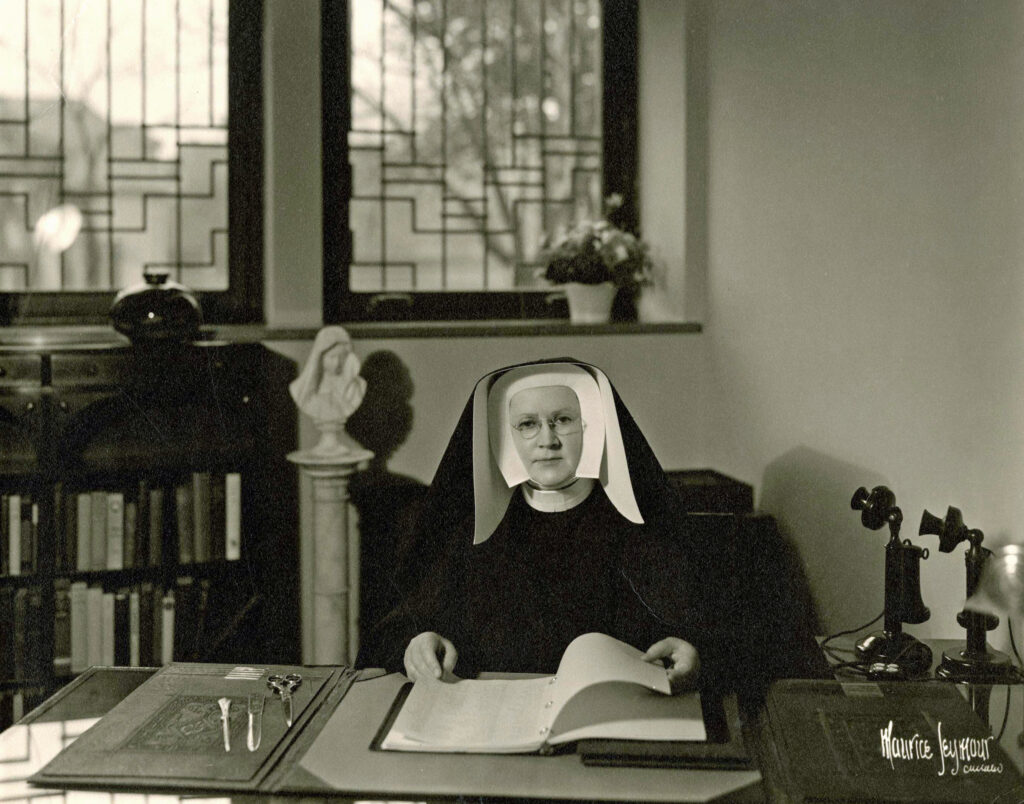This post is part of the WLA blog’s 2022 series written by guest writers. These writers are graduate students in the Public History program at Loyola University Chicago. Each visited the archives during Fall 2021, delved into the collections, and wrote about a topic not yet explored here. We are excited to share their research and perspectives!

One of the most important figures in the history of Mundelein College was Sister Mary Justitia Coffey, BVM, one of its founders and the first president of the women’s Catholic college in Chicago. Revered by her students and colleagues, Coffey was instrumental in building Mundelein as one of the cornerstones of Catholic education in the Midwest. The mark she left on the school and her peers is unmatched. “She had great gifts,” wrote Mundelein College upon the announcement of her passing in 1947. “She had an ideal of Catholic education, uncommon in her time, and she found and used well the vast opportunities that opened before her. She pioneered for higher education for women…her efforts and those of her associates have opened to religious women an unparalleled opportunity for study and research under Catholic leadership” [1].
Born Alice Marie Coffey to Irish immigrants in Massachusetts in 1875, Coffey was consecrated as Sister Mary Justitia in 1903 with the Sisters of Charity of the Blessed Virgin Mary (BVMs). She worked in several different educational institutional institutions, most notably St. Mary’s High School and Immaculate High School, both in Chicago [2]. his made her the perfect candidate to lead the construction of a women’s college in Chicago, an effort led by Cardinal George Mundelein. Coffey was chosen by Mother Mary Isabella of the Sisters of Charity of the Blessed Virgin Mary, the order chosen by Cardinal Mundelein to spearhead the project. When asked, Coffey wrote to Mother Isabella that “I shall do everything in my power, for the intellectual and spiritual success of this enterprise, which you have entrusted to my care” [3].

The site for the college was quickly chosen, and construction began swiftly in 1929. The 14-story building was set to be one of the tallest skyscraper colleges in the world, and Coffey oversaw construction with other nuns appointed by the Sisters of Charity. Coffey and the sisters lived just west of the building, and their supervision was reported by the Chicago Tribune as having “created a sensation from the Vatican to LaSalle Street” [4]. She was known for her selfless attitude, willing to do anything for the school. “To her, the beauty of the building was an educational opportunity, and every element meant to elevate” [5].
Most people assume there are some things you can do nothing about. Sister Mary Justitia never assumed there was nothing you can do.”
Sister Margaret Zonsius
Coffey’s dedication to establishing a world class educational system helped construction continue while the sisters themselves live on pennies, supervising the construction that began less than a week after the stock market crash that began the Great Depression. Yet Sister Coffey was unwavering. As Sister Margaret Zonsius, a colleague of Coffey, noted, “Most people assume there are some things you can do nothing about. Sister Mary Justitia never assumed there was nothing you can do” [6]. Less than a year later, Mundelein opened its doors less than a year after construction began, welcoming over 300 students in September of 1930. With the building completed and the arrival of the first students, Coffey began her new role as the first president of Mundelein College.
Coffey served two separate terms as president, first from 1930-1936 and then again from 1939-1945. During this time, Sister Coffey saw a continually expanding student body of women. She was described by her colleagues as a bold and firm leader. “She was highly motivated…systematic and highly competent. She devoted herself…to planning the curriculum and assembling the faculty” [7]. Her leadership molded Mundelein into an extremely well-organized institution after only one semester open.
“Sister Mary Justitia, supported by her devoted faculty, directed all her resources to the foundation, not only of a great college, but of a great Catholic college, dedicated to the cultivation of strong Catholic womanhood…such achievement, created, inspired, directed, and consummated by the heroic, superhuman selflessness and unconquerable zeal of Sister Mary Justitia…was nourished by the faith and hope and charity, the countless sacrifice of the valiant congregation” [8].
There was a real simplicity about her. Of course it was a small school, but she knew every student and spoke to them by name.
Mundelein College student
It was this unconquerable zeal that colleagues admired in Sister Coffey, and what helped lead Mundelein College’s rapid growth throughout the 1930s and 1940s. Coffey was as a pioneer in Catholic women’s education, and her devotion was noted across the diocese. Her time at Mundelein was halted briefly due to reassignment to Clarke College in Dubuque, Iowa, but upon her return in 1939, she was greeted enthusiastically by the Mundelein faculty and continued her work in educating young Catholic women. One student recalled that “there was a real simplicity about her. Of course it was a small school, but she knew every student and spoke to them by name” [9].
That was Sister Coffey. Demanding, firm, but above all dedicated to the well-being of her students, believing in her own humility while championing these students. Upon her retirement in 1945, she wrote to the Mundelein student body that “your courage, resourcefulness, and ambition which characterized you in the past, will, I am certain, inspire you to do all in your power to make Mundelein College lead among the Catholic colleges for women” [10].

Sister Coffey died just two years later on November 5th, 1947, and in the time of mourning her accomplishments were recognized even further by the Mundelein College community. Countless letters and support were poured in for Sister Coffey, and her funeral was attended by more than 300 of her fellow sisters. Her legacy lives on to this day. Mundelein College erected Coffey Hall, named in her honor, and established a scholarship fund to enable nontraditional women students to earn their degrees [11]. Today, the college she built remains, now merged with Loyola University Chicago, and stands as a monument to Sister Coffey’s commitment to Catholic education. “Time and again, crushing burdens weighed on her heart and mind…but she never lost heart. She never despaired. She never for one moment believed that God would forsake His own work. And she never forgot that the source of Mundelein’s strength and progress is in the prayers of the Congregation to which she belonged” [12]. Always humble, always dedicated, Sister Coffey’s legacy lived on most prominently in the students and staff of Mundelein College.

Noah is a graduate student at Loyola University Chicago studying for an MA in History with an emphasis on Public History. He earned his BA in history from Loyola in 2021.
Endnotes
[1] Mundelein College Faculty Message to the Student Body, 6 November 1947. Women and Leadership Archives, Loyola University Chicago, Box 251, Folder 11.
[2] Coffey, Sister M. Justitia. J.M.J. Questionnaire. Women and Leadership Archives, Loyola University Chicago, Box 251, Folder 11.
[3] Coffey, Sister M. Justitia. Letter to Mother Mary Isabella and Council Members. Women and Leadership Archives, Loyola University Chicago, Box 251, Folder 11.
[4] Mundelein College Alumnae Reunion, Ground Breakers Session. Women and Leadership Archives, Loyola University Chicago, Box 251, Folder 11.
[5] Frisbie, Margaret. “The Nun who Stopped Traffic…and Built a Skyscraper College,” The New World Feature, 14 October 1994. Women and Leadership Archives, Loyola University Chicago, Box 251, Folder 11.
[6] Ibid.
[7] Memories of Sister Mary Justitia Coffey, BVM, 1959. Women and Leadership Archives, Loyola University Chicago, Box 251, Folder 11.
[8] The Chronicle of Mundelein College. Women and Leadership Archives, Loyola University Chicago, Box 251, Folder 11.
[9] Frisbie, Margaret. “The Nun who Stopped Traffic…and Built a Skyscraper College,” The New World Feature, 21 October 1994. Women and Leadership Archives, Loyola University Chicago, Box 251, Folder 11.
[10] Coffey, Sister M. Justitia. Telegram to Student Body of Mundelein College, 25 September 1945. Women and Leadership Archives, Loyola University Chicago, Box 251, Folder 11.
[11] Benz, Sister M. Rita & Rose, Sister M. Shannon. “Coffey, Sister Mary Justitia”, pp. 176-178. Women and Leadership Archives, Loyola University Chicago, Box 251, Folder 11.
[12] Mundelein College Faculty Message to the Student Body, 6 November 1947. Women and Leadership Archives, Loyola University Chicago, Box 251, Folder 11.
[13] Photo of Sister Mary Justitia Coffey. Courtesy of Women and Leadership Archives, Loyola University Chicago, Digital Collections.
[14] Photo of Construction of Mundelein College. Courtesy of Women and Leadership Archives, Loyola University Chicago, Digital Collections.
[15] Photo of Sister Mary Justitia Coffey. Courtesy of Women and Leadership Archives, Loyola University Chicago, Digital Collections.
Loyola University Chicago’s Women and Leadership Archives Blog is designed to provide a positive environment for the Loyola community to discuss important issues and ideas. Differences of opinion are encouraged. We invite comments in response to posts and ask that you write in a civil and respectful manner. All comments will be screened for tone and content and must include the first and last name of the author and a valid email address. The appearance of comments on the blog does not imply the University’s endorsement or acceptance of views expressed. Questions? Please contact the WLA at wlarchives@LUC.edu.
